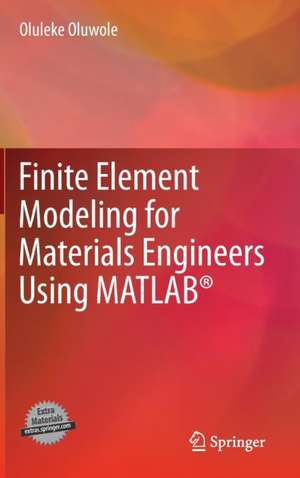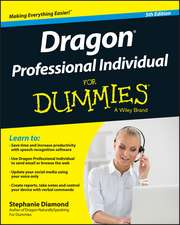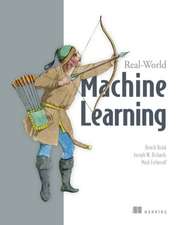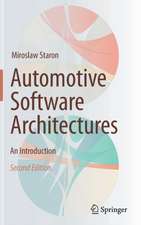Finite Element Modeling for Materials Engineers Using MATLAB®
Autor Oluleke Oluwoleen Limba Engleză Hardback – 23 iul 2011
While treatments of the method itself can be found in many traditional finite element books, Finite Element Modeling for Materials Engineers Using MATLAB® combines the finite element method with MATLAB to offer materials engineers a fast and code-free way of modeling for many materials processes.
Finite Element Modeling for Materials Engineers Using MATLAB® covers such topics as:
- developing a weak formulation as a prelude to obtaining the finite element equation,
- interpolation functions,
- derivation of elemental equations, and
- use of the Partial Differential Equation Toolbox™.
Researchers, advanced undergraduate and postgraduate students, and practitioners in the fields of materials and metallurgy will find Finite Element Modeling for Materials Engineers Using MATLAB® a useful guide to using MATLAB for engineering analysis and decision-making.
| Toate formatele și edițiile | Preț | Express |
|---|---|---|
| Paperback (1) | 637.56 lei 6-8 săpt. | |
| SPRINGER LONDON – 30 noi 2014 | 637.56 lei 6-8 săpt. | |
| Hardback (1) | 588.81 lei 38-44 zile | |
| SPRINGER LONDON – 23 iul 2011 | 588.81 lei 38-44 zile |
Preț: 588.81 lei
Preț vechi: 736.01 lei
-20% Nou
Puncte Express: 883
Preț estimativ în valută:
112.68€ • 122.36$ • 94.65£
112.68€ • 122.36$ • 94.65£
Carte tipărită la comandă
Livrare economică 18-24 aprilie
Preluare comenzi: 021 569.72.76
Specificații
ISBN-13: 9780857296603
ISBN-10: 0857296604
Pagini: 120
Ilustrații: XI, 120 p. With online files/update.
Dimensiuni: 155 x 235 x 15 mm
Greutate: 0.32 kg
Ediția:2011
Editura: SPRINGER LONDON
Colecția Springer
Locul publicării:London, United Kingdom
ISBN-10: 0857296604
Pagini: 120
Ilustrații: XI, 120 p. With online files/update.
Dimensiuni: 155 x 235 x 15 mm
Greutate: 0.32 kg
Ediția:2011
Editura: SPRINGER LONDON
Colecția Springer
Locul publicării:London, United Kingdom
Public țintă
ResearchCuprins
1. The Weak Formulation.- 2. Linear Interpolation Functions.- 3.Derivation of Element Matrices and Solution of the Finite Element Equation.- 4. Steps to Modeling Using PDEToolBox Graphics Interface.- 5. Application of PDEToolBox to Heat Transfer Problems.- 6. Application of PDEToolBox to Elasticity Problems.
Notă biografică
Oluleke Oluwole is a Senior Lecturer and former Ag. Head of the Mechanical Engineering Department at the University of Ibadan, Ibadan, Nigeria. He has also lectured at Obafemi Awolowo University, Ile-ife, Nigeria. Outside academia he has been Production Engineer at the Coksee Engineering Works, Lagos, Nigeria, and Controller at GP Cars, London, UK. He has published several papers in international journals.
Textul de pe ultima copertă
The finite element method is often used for numerical computation in the applied sciences. It makes a major contribution to the range of numerical methods used in the simulation of systems and irregular domains, and its importance today has made it an important subject of study for all engineering students.
While treatments of the method itself can be found in many traditional finite element books, Finite Element Modeling for Materials Engineers Using MATLAB® combines the finite element method with MATLAB to offer materials engineers a fast and code-free way of modeling for many materials processes.
Finite Element Modeling for Materials Engineers Using MATLAB® covers such topics as:
Researchers, advanced undergraduate and postgraduate students, and practitioners in the fields of materials and metallurgy will find Finite Element Modeling for Materials Engineers Using MATLAB® a useful guide to using MATLAB for engineering analysis and decision-making.
While treatments of the method itself can be found in many traditional finite element books, Finite Element Modeling for Materials Engineers Using MATLAB® combines the finite element method with MATLAB to offer materials engineers a fast and code-free way of modeling for many materials processes.
Finite Element Modeling for Materials Engineers Using MATLAB® covers such topics as:
- developing a weak formulation as a prelude to obtaining the finite element equation,
- interpolation functions,
- derivation of elemental equations, and
- use of the Partial Differential Equation Toolbox™.
Researchers, advanced undergraduate and postgraduate students, and practitioners in the fields of materials and metallurgy will find Finite Element Modeling for Materials Engineers Using MATLAB® a useful guide to using MATLAB for engineering analysis and decision-making.
Caracteristici
Discusses the finite element method with a particular focus on the requirements of materials engineers Uses the MATLAB® pdetool to develop a code-free way of modelling Contains exercises to help develop the reader's understanding






















